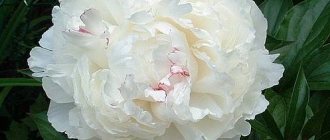Planting perennial flowers in the fall means providing your flowerbed with strong plants that bloom a couple of weeks earlier. Sowing before winter solves many problems associated with the care and cultivation of crops. When planting in autumn, there is no need for stratification of seeds, their natural selection occurs, thanks to which only high-quality seedlings that are resistant to diseases and frosts germinate.
Autumn planting of perennial flowers guarantees their high stability
What perennial flowers can be planted in the fall before winter?
Not all perennials are best planted in the fall. This rule is only suitable for those flowers whose sprouts are resistant to getting wet and can withstand frost. This applies to delphinium, lavender, primrose, aquilegia and a number of other crops. In addition to flowers that can be sown with seeds, bulbous plants are also planted before winter. For example, tulips, muscari, hyacinths, irises, they will show better results when planted in the fall than in the spring. When sown before winter, they often begin to bloom as early as April - May, even if they should do so in the second year.
Advice! Autumn planting of perennial crops should be approached wisely. It is not recommended to sow all the plants you like at the same time.
In September
The first candidates for planting in the fall are bulbous and rhizomatous perennials, since they require a period of cold dormancy to flower. From the end of August to the last days of September, you can plant:
- muscari;
- gaillardia;
- crocuses;
- daffodils;
- garden geranium;
- phlox;
- primrose;
- rudbeckia;
- grouse;
- yarrow;
- Chionodoxa;
- solidago.
Perennial flowers that should be planted first are pansies, daisies and forget-me-nots. Sown at the beginning of September, they will sprout quickly, have time to get stronger before the weather gets cold, in winter they will go under the snow along with the leaves, and will bloom in April.
By the end of September, starting from the 20th, it is time to plant and replant daylilies, tulips and lilies. When purchasing bulbs, you should carefully inspect them, purchase only high-quality material, without signs of drying out, rot or mold.
In October, November
At the beginning of October, preferably in its first ten days, it is still possible to plant tulips. This is also the time for hyacinths. The timing of the procedure may depend on the growing region and weather conditions. The general rule is an average daily temperature of +5 degrees and above.
In late autumn, at the end of October - November, you can plant perennial flowers that need stratification. These include:
- aquilegia;
- arabis;
- monkshood;
- helenium;
- Iberis;
- delphinium;
- gypsophila;
- lupine;
- lavender;
- rudbeckia;
- sedum;
- phlox;
- Echinacea.
Warning! When planting in the fall, flower seeds should be sown thickly; it is advisable to sprinkle them with peat or dry leaves on top.
Rose cuttings
In autumn, it is best to plant rooted cuttings and rose seedlings after pruning faded bushes. You will need to cut off the strongest shoots that had flowers. Any cutting should have 4–5 internodes. Partially cut off the leaves from the cuttings and plant them on a bed of soil and sand at an angle of 45 degrees. Cover the planted cuttings on top with a glass jar. Wrap the rose garden in agrospan for winter. In the spring, remove the agrospan and leave the jars until June so that the threat of frost passes.
Advantages and disadvantages of planting and replanting perennial flowers in the fall
Autumn planting of perennial flowering crops has its pros and cons, but there are many more positive aspects.
Read more Perennial flowers with lilac and purple flowers
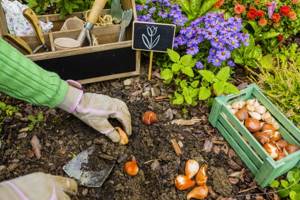
Perennial flowers that are planted in the fall grow strong and hardened
The advantages of the procedure include:
- strength and endurance of seedlings;
- disease resistance;
- adaptation to unfavorable conditions;
- natural stratification;
- dense shoots;
- early growing season;
- flowering in the first year.
In addition, the procedure does not require haste, you can do everything in a measured manner, and carefully think through the design of the flowerbed.
The disadvantages of planting flowers in the fall are:
- increasing the amount of seed;
- uncomfortable working conditions.
Peonies
Peonies can bloom in one place for many years, but periodic replanting and dividing the bush are necessary for flowering activity. This should be done in late summer or early autumn. During this period, the suction rhizomes die off, and the main root is ready to be divided into fractions without any problems. The maximum planting period is 30 days before cold weather. The bush should not be replanted later, as the roots must adapt to the new area. When severe cold occurs, it is better to cover the planting with spruce branches.
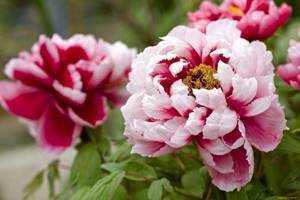
Top 10 most popular perennials that are planted with seeds in the fall
Flowers planted before winter will grow lush, beautiful and resistant to many diseases in the next season. They can be sown from the end of September to December, depending on the air temperature and weather conditions. Below are the most popular perennial flowers and their photos, which are best to plant in the fall.
Aquilegia
Aquilegia - flowers of unusual shape, with a variety of colors. Excellent for mixed borders, borders and borders. It is better to sow the seeds of the crop in mid-autumn (October - early November), when the soil has cooled to +2-4 degrees. Planting material is used in dry form, without soaking or other treatments.
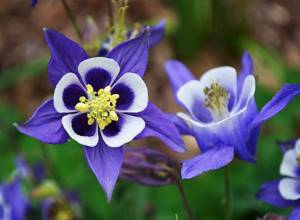
Aquilegia shows best results in partial shade
Arabis
Arabis (Arabis) is a ground cover crop with double or single inflorescences of purple, yellow and pink colors. It looks interesting in the foreground of the flower bed. Seeds are sown before winter in open ground in October.
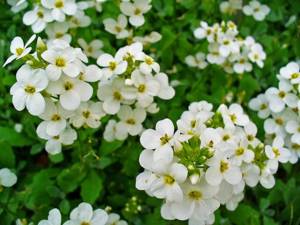
Arabis prefers good lighting and sandy substrate
Gaillardia
Gaillardia - yellow-golden flowers with a height of 25 to 60 cm. They grow in well-drained soil and do not like waterlogging. When planting in the fall, the seeds of the crop are simply scattered over the garden bed and lightly sprinkled with soil. If in the growing region the temperature in winter drops below -18 degrees, then the beds are covered with covering material.
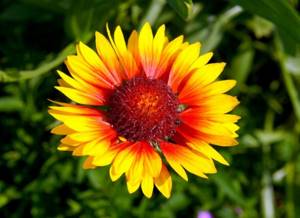
Gaillardia is suitable for decorating flower beds located in a sunny area
Garden geranium
Garden geranium (Geranium hortorum) are universal flowers that can be used to decorate any natural areas of the site, as well as alpine slides and rockeries. Today, 300 varieties of this perennial plant are known, with different parameters: the size of the bushes, the size of the leaf blades, and colors.

Planting garden geraniums before winter should be done in early autumn
Delphinium
Delphinium (Delphinium) is a tall perennial plant from 0.8 to 2 m. They delight gardeners with a variety of varieties, including double varieties, in different shades: purple, snow-white, pink, blue. The seeds of the crop germinate only after stratification, so it is best to plant them before winter. The procedure is performed in late autumn, in November, in slightly frozen ground.
Read more Border flowers perennials
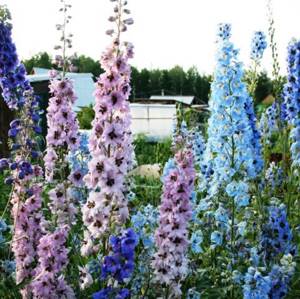
Delphinium is planted when the threat of a return thaw has passed.
Bluebell Carpathian
This variety of bellflower (Campanula carpatica) grows up to 30 cm in height, the flowers come in blue, white, purple, and cyan colors. The plant does not tolerate stagnant moisture and is suitable for rock gardens and rocky gardens. Planting bells before winter is done at the end of October, so the seeds will undergo stratification and spring up in the flowerbed in spring.
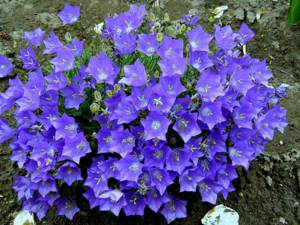
Carpathian bell should be grown in lighted areas
Lavender
Many gardeners love purple lavender bushes (Lavandula) not only for their attractive appearance, but also for their enchanting aroma. The plant, depending on the variety, can have different heights. Prefers loose soil with a neutral pH. Planting lavender in the fall is the best option. The procedure is carried out during stable frosts, in late October - November.
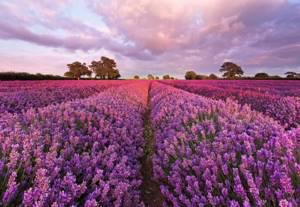
Lavender is used to decorate borders, alpine slides and rockeries
Lupine
Lupine (Lupinus) is a plant very popular among gardeners. They are grown not only as decorative flowers, but also as a fodder crop, green manure and medicinal product. Perennial varieties have different colors: blue, red, yellow, purple, white. Planting lupine is a simple process; it is sown in the fall from October to December, when the top layer of soil has cooled a little.

Lupine seeds undergo mandatory stratification
Primrose
Primula is a spring primrose, which has about 500 species. It is best to plant it in the fall, towards the end of September. The optimal place for the plant will be partial shade emanating from bushes and trees.
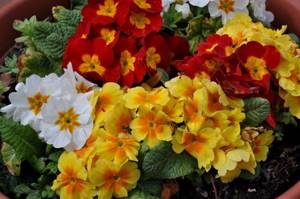
The soil where primrose grows must be moist and fertile.
Yarrow
Yarrow (Millefolium) is an unpretentious plant with white, pink and yellow inflorescences. Prefers good lighting, suitable for both single and group plantings. To speed up the growing season of the crop, it is sown in early autumn. The seeds are scattered superficially, then sprinkled with a thin layer of soil.
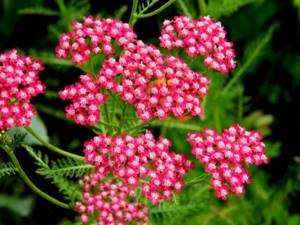
Yarrow can be grown in any soil
Annual aster
Sowing asters before winter reduces the risk of the seeds spreading fungal diseases, which cause great damage to flowers. Overwintered plants are stronger and therefore bloom early. A sunny, high place with low acidity and oxygen-enriched soil is required. This way, water will not linger in the soil, and it will warm up faster.
Applying fresh manure is contraindicated; it is better to treat the beds with Fitosporin or Maxim. To protect the bed, it is better to mulch it with peat or a layer of sawdust.
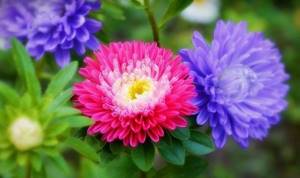
Top 7 most popular perennial bulbous flowers for planting in autumn
Gardeners who dream of a garden blooming and fragrant when the snow has barely melted try to plant bulbous perennial flowers in the fall. This time of year is considered the best for planting them.
Important! It is optimal to have time to carry out the procedure two to three weeks before frost.
Hyacinth
Hyacinths (Hyacinthus) are one of the first and brightest flowers to decorate the garden in early spring. In the middle zone, it needs to be dug up after flowering and then planted in the fall. Bulbs are planted when the soil temperature drops to +5-9 degrees, around the end of September. Then the area is insulated with sawdust, compost or leaves.
Read more Blue and blue perennials: photos and names, top blooming all summer
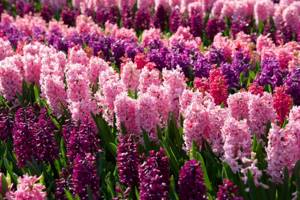
The right time for planting perennial hyacinths is of great importance.
Iris
Iris (Iris) are perennial flowers that are planted in the fall in order to obtain more lush and abundant flowering. If you plant the bulbs in September - October, they will have time to take root before frost, will survive the winter well and will begin to grow early in the spring.
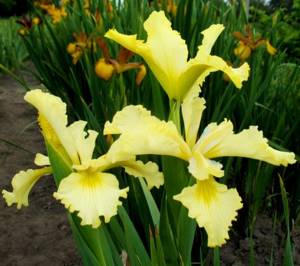
Irises grow best in sunny beds in loamy and slightly acidic soil.
Crocus
Crocus (Crocus) is a beautiful primrose, ideal for borders, alpine slides and tree trunks. Gardeners love it for its unpretentiousness and rich color palette. The most suitable time for planting perennial crocus corms is autumn. Approximately, they are planted in the ground in early September, a month before the onset of the first autumn frosts.
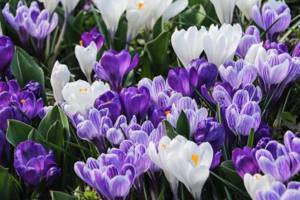
When planting crocuses, it is important to focus on weather conditions
Lily
Lilies (Lilium) are beautiful graceful flowers, represented by many varieties and a variety of colors. Like many other bulbous perennials, they are usually planted in the fall, a month before the first frost. Planting times may vary in different regions.
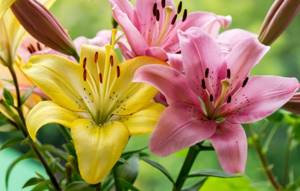
The optimal temperature for planting lilies is +10 degrees
Muscari
Muscari are unpretentious perennial flowers with bright blue inflorescences, similar in appearance to hyacinths. They are the first to bloom in flower beds, almost immediately after the snow melts. The culture is completely unpretentious. Even a novice gardener can grow it.
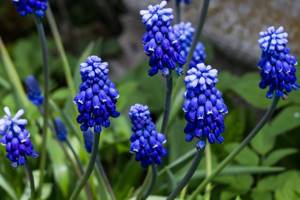
Muscari is usually planted in the fall until mid-October
Narcissus
Daffodils (Narcissus) are elegant flowers with a delicate aroma that adorn almost every garden plot. The optimal time for planting their bulbs is considered to be the beginning of autumn. The main condition is that the soil temperature within two weeks after planting should not fall below 10 degrees.
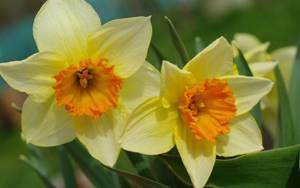
Narcissus bulbs take about 20 days to take root.
Tulip
Tulip (Tulipa) is a popular and most common bulbous perennial flower that blooms in spring. Their plantings look great in any flower bed, border or pot. The culture is completely unpretentious in care and planting. From the point of view of adaptation, their autumn planting is considered the most optimal, since in this case they will have more stable immunity and will bloom earlier than expected.
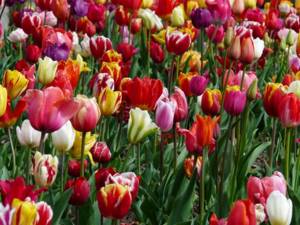
It is recommended to plant tulips in autumn from the second week of September to October 10
How to choose a place and time?
To prevent overwintered seeds from being washed away by water when the snow melts, you need to sow the plants at higher elevations. If you do not have a suitable place, experienced gardeners recommend fencing flower beds with various available materials. Most often, fences are made of slate, plywood or curb tape.
In addition, before autumn work on the soil, you need to decide whether the crops are being brought into a permanent place or whether they will have to be replanted. In this case, it is taken into account that annuals tolerate movement to a new territory less well than perennial flowers. If you disturb the plants “for the season,” they will be reluctant to bloom and will begin to get sick.
For each flower that is suitable for autumn-winter plantings, there is an optimal time for planting in the ground. Usually, on packets of seeds, the manufacturer indicates the months suitable for sowing. If you miss the moment, the crop may not survive the cold and die.
Lavatera
Wild Lavatera rose is a beautiful flower that does not require constant care. Lavatera is an ideal plant for a decorative flower garden; it is easy to keep in containers and plant in borders. After planting, the plant develops well and then blooms thickly and brightly. Lavatera requires loosened soil, scanty watering and fertilizing when the soil is as depleted as possible.
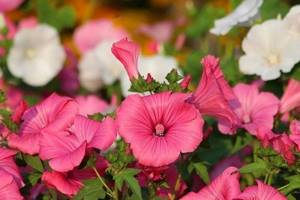
Astilbe
Astilbe can actively bloom in one place for more than 10 years. Replanting every 4 years is necessary for the recovery and active flowering of astilbe. In the first weeks of October, before the start of the long rainy season and after the burning sun has stopped, you need to plant astilbe in a shaded place with good moisture. Ideal for placing areas along the walls, where melt water and rain flow from the sloping roof. Moisture-loving astilbe will decorate the area and drain the areas around the foundation.
